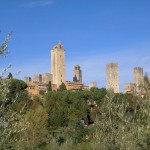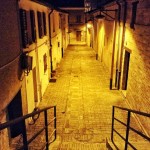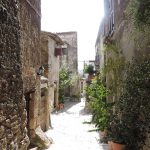That's the Tuscany you are looking for
Have you ever been to Spoleto?
Hesse and Goethe fell in love with it
by Federica Cagnoni.
I Cannot leave Umbria without talking about it: Spoleto is the most beautiful discovery I made in Italy… there is such a wealth of unkown beauties, mountains, valleys, forests of oaks, monasteries and waterfalls…
(H. Hesse)I climbed up to Spoleto and was on the acqueduct which also serves as a bridge between the two mountains. The ten arches of brickwork have stood there so calmly during the centuries, and water still gushes forth everywhere in Spoleto. This is now the third structure I have seen, all of them with the same grandeur of design. A second Nature, one that serves civic goals, that is what their architecture is, and thus arose the amphitheater, the temple ad the acqueduct…
(Italian Journey, J.W. Goethe)
First day
We approach the town from South and, travelling along the Via Flaminia, we face one of the masterpiece of the Roman architecture: the Ponte delle Torri, that was built as an acqueduct and now it rapresents a link between the town and the mountains on the other side of the valley. It’s amazing how it stands there in all its majesty… so high, so great and so beautiful!
Before passing it, you can have access to the town and following the main road you will start finding on your right the ancient walls that still stand there to divide the eldest part of the city from the most modern one. You can enter the town from the main entrance in Garibaldi Square and go uphill till the Fortress. Some years ago escalators have been installed in the Eastern side that takes you directly under the fortress but a nice walk is noteworthy.
Spoleto is full of Romanic churches and the first example can be found in Garibaldi Square. with San Gregorio Square. After having visited the whole Sicily, it’s surprising how essential and minimalist the architecture becomes… I like it much more because it looks like much more cleaned, simple even if the details of Baroque churches are impressive.
We start doing our “vasca” as the locals are used to call the continuous walk back and forth along the so called “Borgo”, that is simple a street full of shops that leads you to the upper part of the town but, if you come here at about 6 o’ clock in the evening it gets so crowded that it gets difficult to walk.
At the end of this street you can see the Porta Fuga (Escape entrance), whose name dates back to the III century B.C., when Hannibal was scared off from the inhabitants as proved by the inscription you can see in the arch:
Annibal caesis ad Trasimenum Romanis urbem Romam infenso agmine petens Spoleto magna suorum caede repulsus insigni fuga portae nomen fecit.
Just before it, on the left, you find Palazzo Vigili with its Tower, the only one that still preserves its original height.
The so called Oil tower dates back to the XIII century when it was used as a defence system from where, in case of attacks, boiling oil was poured down from the small slots.
It’s lunch time and we want to reach the old Market square because every day, during the week, Serafino stands there with its van and you can taste on of the best “Panino con la porchetta” of the town. I still wonder how is it possible that every day he succeeds in selling the whole pig!
The square market, in the morning, is full of farmers who sell their products. On the left side you can admire the Spring of the square and it follows the Roman habit of “water exhibitions”.
On the left side of the fountain you can find the ancient “Roman house” of the I century b.C. that was found under the current City Hall. Decorations, Mosaics and the houseplant let us think that this was an example of an original Domus Romana belonging to a wealthy family. After the visit of the Roman House, go out and cross the Market square till the opposite side and pass under the Arch of Druzus that was build in 23 A.D. in honour of Drusus, the son of the Emperor Tiberius and it rapresented the entrance to the ancient Forum.
Then turn right and start the descent and you will reach a little square, Piazza della Libertà where, in the corner, you can admire the ancient Roman Theatre, whose entrance is in Via S. Agata.
Second day
The following day, have breakfast at Tebro (Via Minervio, 1) or at Zampolini (Viale Trento e Trieste, 24) breakfast, enjoy the delighs of Italian pastry… Taste one of the best maritozzoin town… It looks so big, but never mind it will finish in a hurry.
After having restored yourself with so many calories, you can face the ascent to the fortress, La Rocca. Today our tour is downhill, but we must start from the upper part of the town: Sant’Elia hill. The building goes back to the XIV century, when the Pope who lived in Avignon wanted to build some mansions in the lands belonging to the Church. Later it became the residence of the Lords of the town and its walls were painted with many frescoes. Nowadays you can visit the interior, even if you won’t find them completly preserved. In the XIX century it became a prison and most of the decorations were covered. After going out of the fortress, you must take a tour around it. The locals do it very often: it is very nice, because from here you can see the whole town and you can reach the entrance of the Tower Bridge, that you can cross.
Then, you can start your descent, you will cross a little park and take the street downhill. On your right you will see a difference in level that will lead you to the Dom of Spoleto, known as Cathedral of Holy Mary. It is a typical example of Romanic architecture, built in the XII century, apart for the Renaissance porch and the interiors. Inside you can admire some masterpieces from the artists Pinturicchio and Bernini. After going out, turn right and get off the stairs, follow the street and you will reach the Church and Cloister of Saint Nicolò, one of the most important Italian cultural centres.
“Festival dei due mondi”
(Two worlds festival)
Spoleto is known all over the world for the Festival dei 2 Mondi (that is “of the two worlds”) an international musical, artistic and cultural show that attracts visitors from all over the world. It takes place every year in the second half of June and lasts 3 weeks. One of the most famous event is the final concert held on Dom Square.
Spoleto is the right location because you can find a lot of theatres and places where artists can perform. Hereafter, you can find some examples:
- The Roman theatre we visited yesterday: the right location for ballet;
- Theatre Caio Melisso that is located next to the Dom: for prose performances;
- The courtyard of the fortress: for concerts;
- The New Theatre, the biggest Italian Style theatre in Umbria, dedicated to the patron of the Festival, Giancarlo Menotti. The interior of this theatre and the private rooms are something astonishing.
You can relax here and there and find out beautiful spots where to rest and to absorb the peace that this place can offer you.
Moreover you can taste in all trattorias the typical products this land can offer you, such as:
Recipe of the Omelette with asparagus
Ingredients:
2 eggs for each person;
a bunch of asparagus;
garlic;
chili pepper;
oil.
Fry the garlic with the oil in a pan and add the chili. In the meantime you will have washed and cut in pieces the asparagus; pour them in the fry, add some water until the vegetables are cooked. Pour the beaten eggs in the pan and cook the omelet until both sides are golden.
Federica Cagnoni
Main image courtesy of Christopher John SSF (Flickr user Friar’s Balsam)














